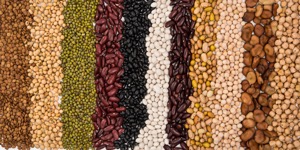The influence of pulses on pet health

Understanding the benefits and potential risks of pulses in pet diets.
FDA report
A report from the FDA in July 2018 caused significant interest in dilated cardiomyopathy (DCM). The report suggested that the incidence of DCM was increasing in dogs and that it was associated with the rise of grain-free diets, specifically due to ingredients such as ‘peas, lentils, other legume seeds or potatoes’. Grain legumes or pulses – such as beans, peas, lentils and chickpeas – are generally higher in protein than traditional grains (for example corn, wheat, rice). Pulses also fill an important sustainability niche by fixing nitrogen in soil. But are they healthy for pets?
Are pulses healthy for pets?
Research in dogs indicates that lentil- and pea-containing diets tend to delay the glycaemic spike following meal consumption compared to diets containing rice flour, corn flour and cassava flour. In cats, diets containing lentils and peas resulted in more favourable glucose and insulin events following meal ingestion than corn-based diets. Consumption of lentils by both dogs and humans tended to slow gastric emptying, which perhaps explains why pulses may attenuate the glucose spike following a meal. Palatability and stool quality of dogs was maintained in the case of diets containing up to 20% fava beans.
Studies
While the understanding of the impact of pulses on dog or cat health is still limited, a rather large body of evidence exists for their impact on human health. A four-year-long study tracked the incidence of diabetes in over 3,000 humans. The results indicated that increased consumption of total legumes – and specifically lentils – was significantly associated with decreased occurrence of type 2 diabetes. Increased consumption of chickpeas also tended to be associated with decreased incidence of type 2 diabetes.
A review of 21 studies comprising nearly a thousand individuals was undertaken to determine the impact of pulse consumption on various obesity characteristics. Across all studies, an average of 0.34 kg in body weight was lost within a six-week period. Further, six of the studies provided evidence of body fat reduction linked to pulse consumption. Given these results, it is not surprising that a review of nine clinical trials revealed that consumption of pulses improved satiety.
Brain response
Scientific literature has shown that events in the gut provide feedback to the brain. A recent review of five studies suggests that consumption of pulses changes the composition of large intestine microbiota. While speculative, it is possible that changes in the gut microbiome elicit a satiety response by the brain.
Conclusion
Pulses play an important sustainability role, plus research data from pets and humans indicates that pulses provide important health benefits related to obesity and diabetes. It remains to be seen whether the ongoing DCM debate will hinder access to the health benefits of pulses for pets.
